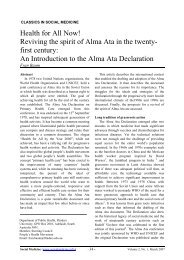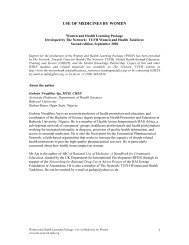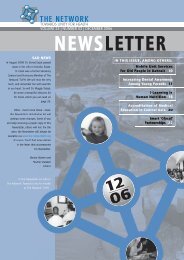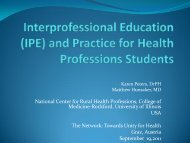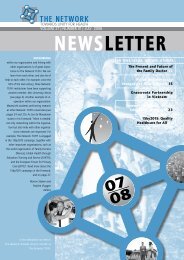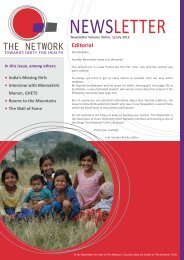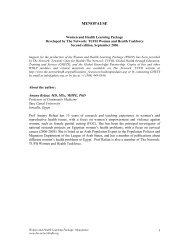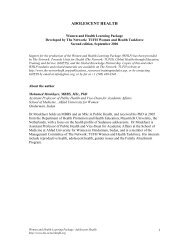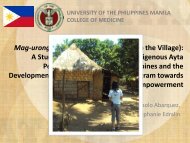WHLP MTCT HIV_AIDS.pdf - The network - Towards Unity For Health
WHLP MTCT HIV_AIDS.pdf - The network - Towards Unity For Health
WHLP MTCT HIV_AIDS.pdf - The network - Towards Unity For Health
Create successful ePaper yourself
Turn your PDF publications into a flip-book with our unique Google optimized e-Paper software.
MOTHER-TO-CHILD TRANSMISSION (<strong>MTCT</strong>) OF <strong>HIV</strong>/<strong>AIDS</strong>Women and <strong>Health</strong> Learning PackageDeveloped by <strong>The</strong> Network: TUFH Women and <strong>Health</strong> TaskforceSecond edition, September 2006Support for the production of the Women and <strong>Health</strong> Learning Package (<strong>WHLP</strong>) has been providedby <strong>The</strong> Network: <strong>Towards</strong> <strong>Unity</strong> for <strong>Health</strong> (<strong>The</strong> Network: TUFH), Global <strong>Health</strong> through Education,Training and Service (GHETS), and the Global Knowledge Partnership. Copies of this and other<strong>WHLP</strong> modules and related materials are available on <strong>The</strong> Network: TUFH website athttp://www.the-<strong>network</strong>tufh.org/publications_resources/trainingmodules.asp or by contacting GHETSby email at info@ghets.org, or by fax at +1 (508) 448-8346.About the authorRosebella O. Onyango, BEd, MSc, (Community <strong>Health</strong>), PhD (Childhood Nutrition)Senior Lecturer and Director, School of Public <strong>Health</strong> and Community DevelopmentMaseno UniversityMaseno, KenyaDr Onyango is a public health nutritionist and a trained teacher and researcher, with manyyears of teaching, administrative, and research experience at various educational levels.Eighteen years of that experience have been in teacher training institutions and universities.She is also an external examiner for nutrition exams in Egerton and Moi Universities, Kenya.She supervises postgraduate students on a variety of nutrition and public health researchprojects.Dr Onyango has carried out studies on infant feeding in the <strong>HIV</strong>/<strong>AIDS</strong> era, nutritional statusand health of children, and related family socioeconomic and environmental factors. Herresearch focus is on both pre-school children and women. She has worked with women’sgroups in slums and rural settings to improve of maternal and child health and nutrition. Sheis a member of Kenya Coalition for Action in Nutrition (K-CAN) and Regional Centre ofQuality <strong>Health</strong> Care (RCQHC). She is also a member of <strong>The</strong> Network: TUFH Women and<strong>Health</strong> Taskforce.Her current research interests are in infant feeding in the <strong>HIV</strong>/<strong>AIDS</strong> era and home-basedhealth care for people living with <strong>HIV</strong>/<strong>AIDS</strong> (PLWHA). Dr Onyango is a trainer of trainersfor nurses and other health workers in prevention of mother-to-child transmission (P<strong>MTCT</strong>)of <strong>HIV</strong>.Women and <strong>Health</strong> Learning Package: <strong>MTCT</strong> of <strong>HIV</strong>/<strong>AIDS</strong>www.the-<strong>network</strong>tufh.org1
MOTHER-TO-CHILD TRANSMISSION (<strong>MTCT</strong>) OF <strong>HIV</strong>/<strong>AIDS</strong>Global Overview<strong>The</strong> <strong>HIV</strong>/<strong>AIDS</strong> epidemic has become a major problem in many countries globally andcontinues to have a devastating effect on sub-Saharan Africa. <strong>The</strong> overwhelming majority of<strong>HIV</strong>-infected people—more than 90%—live in developing countries. Adults living in sub-Saharan Africa are 10 times more likely to be infected with <strong>HIV</strong> than adults living in NorthAmerica, and 20 times more likely than adults living in Western Europe. Eighty percent ofwomen currently living with <strong>HIV</strong> are in sub-Saharan Africa, and out of all the children bornwith <strong>HIV</strong> globally, 90% are in this same region.Prevention of mother-to-child transmission (<strong>MTCT</strong>) of <strong>HIV</strong>—also known as vertical,perinatal or parent-to-child transmission (PTCT) to reflect the role of men in the overall chainof transmission— has become a priority for many developing country governments andagencies. This priority is consistent not only with the broader goals of <strong>HIV</strong>/<strong>AIDS</strong> prevention,but also with commitments to improving child health and survival.Infants and children in Africa are infected by <strong>HIV</strong>/<strong>AIDS</strong> in multiple ways. Those who aremost directly affected are children who acquire <strong>HIV</strong>/<strong>AIDS</strong> through <strong>MTCT</strong>. <strong>The</strong>y face severemorbidity and near-certain death where sophisticated and costly treatments are nonexistentand even the availability of basic medicines to treat opportunistic infections is likely to beerratic. Infant mortality rates, although reduced between 1981 and 1986, have now risendramatically, largely due to <strong>AIDS</strong>. Almost all <strong>AIDS</strong> deaths in Africa in young children canbe traced back to <strong>MTCT</strong>.In developed countries, <strong>MTCT</strong> rates have fallen to as low as 2% of births among <strong>HIV</strong>infectedmothers in recent years with the introduction of <strong>HIV</strong> counselling and testing, shortcoursezidovudine (ZDV) or azidothymadine (AZT) prophylaxis, elective Caesarean deliveryand safe use of infant formula instead of breastfeeding. In Africa, however, where prolongedbreastfeeding is the norm, about 25-35% of <strong>HIV</strong>-infected mothers pass on the disease to theirinfants.<strong>The</strong> severity of the <strong>MTCT</strong> problem in sub-Saharan Africa is due to a number of factors,including high rates of <strong>HIV</strong> infection in women of reproductive age, a large total populationof women of reproductive age, high birth rates, and a lack of effective <strong>MTCT</strong> preventioninterventions. Rates of infections in women are high in sub-Saharan Africa and are growingrapidly.Transmission of <strong>HIV</strong> through breast milk is of concern in many developing countries where<strong>HIV</strong> infection in women is common and breastfeeding is universally practiced. In Africa, 30-40% of children born to <strong>HIV</strong>-infected women acquire <strong>HIV</strong>, and 30-50% of infected infantsacquire the disease through breastfeeding. This has reversed previous gains made in childsurvival and has eroded health worker confidence in recommending breastfeeding as the bestand safest form of infant feeding.Promotion of exclusive breastfeeding as the best possible nutrition for infants has been thecornerstone of child health and survival strategies for the past 20 years, and has played amajor part in lowering infant mortality in many regions of the world. <strong>The</strong>refore, the evidencethat has accrued over recent years that breast milk is a significant source of <strong>HIV</strong> infection hasWomen and <strong>Health</strong> Learning Package: <strong>MTCT</strong> of <strong>HIV</strong>/<strong>AIDS</strong>www.the-<strong>network</strong>tufh.org2
caused a real dilemma for mothers, health personnel, and policymakers. Today, decisionsabout infant feeding in settings of high <strong>HIV</strong> prevalence require a careful balancing of risks,with the risk of transmitting <strong>HIV</strong> on one side and the risk of morbidity, mortality andstigmatisation that can result from not breastfeeding on the other. Breastfeeding is nearlyuniversal in Africa, making balancing the risks especially challenging.Malnutrition has been endemic in Africa for decades, complicated by a combination offactors and more recently by the impact of <strong>AIDS</strong>. It is estimated that one-third of all childrenunder five in sub-Saharan Africa are stunted, and more than half suffer from some form ofmicronutrient malnutrition. Malnutrition is also common among adults in most parts ofAfrica, where more than half of all pregnant women suffer from anaemia.<strong>HIV</strong>/<strong>AIDS</strong> and malnutrition are inextricably interrelated. Studies show that malnutritionincreases both the risk of <strong>HIV</strong> transmission from mothers to babies and the progression of the<strong>HIV</strong> infection. In turn, <strong>HIV</strong> infection exacerbates malnutrition through its attacks on theimmune system and its impact on nutrient intake, absorption, and utilisation. This puts thelives of <strong>HIV</strong>-infected infants at risk from both malnutrition and <strong>AIDS</strong>-related infections.<strong>The</strong> severity of the <strong>MTCT</strong> problem in sub-Saharan Africa is due to high rates of <strong>HIV</strong>infection in women of reproductive age, a large total population of women of reproductiveage, high birth rates, and the lack of effective <strong>MTCT</strong> prevention intervention.An estimated 330,000 children younger than five died in the sub-Saharan Africa in 1999 from<strong>HIV</strong> infections. Four countries (Botswana, Namibia, Swaziland, and Zimbabwe) have rates of<strong>HIV</strong>-attributable under-five mortality of above 30 per 1000, and an additional 16 countrieshave rates between 10 and 25 per 1000.Regional Overview: KenyaWomen and <strong>Health</strong> Learning Package: <strong>MTCT</strong> of <strong>HIV</strong>/<strong>AIDS</strong>www.the-<strong>network</strong>tufh.org3
Population Profile: KenyaTotal Population31.3 millionAnnual Population growth Rate (%) 1.53Rate of annual increase in population 3.5%Total Fertility Rates (TFR) (15-49 years) 5.0Infant Mortality Rate (IMR)(Per 1000) 78Under-five Mortality Rate 114Crude birth rate (per 1000 live births) 29.35Crude death rate (per 1000 live births) 14.8Life expectancy (women)49 years<strong>HIV</strong>-infected1.4 million<strong>AIDS</strong> deaths 140,000 adults in 2003<strong>AIDS</strong> orphans 890,000<strong>HIV</strong> Prevalence (women 15-49) in Urban 12.3%<strong>HIV</strong> Prevalence (women 15-49) in Rural 7.5%<strong>HIV</strong> Prevalence (men 15-49) In Urban 7.6%<strong>HIV</strong> Prevalence (men 15-49) In Rural 3.5%<strong>HIV</strong> Prevalence (women 15-49) Total 8.7%<strong>HIV</strong> Prevalence (men 15-49) Total 4.5%<strong>HIV</strong> Prevalence Total 6.7%It is estimated that 2.2 million Kenyans are now living with <strong>HIV</strong>, but few of them know thatthey are infected or show symptoms of the disease, and only about 200,000 have <strong>AIDS</strong>(Government of Kenya, 2001). Results of the Kenya Demographic and <strong>Health</strong> Survey(KDHS) in 2003 indicated that the national prevalence rate derived from women participatingin a 2003 sentinel surveillance program was 9.4%. Gender differences were most striking inyoung people. In the 15-19 age group, 3.5% of women and only 0.5% of men were infected,while in the 20-24 year age group, 8.7% of women and 2.4% of men were infected (KDHS,2003). It is projected that <strong>AIDS</strong> will increase the death rate at all ages. However, the impactwill be most severe among young adults and children under the age of five. This rapidincrease in young adult deaths will have serious consequences for economic and socialdevelopment.Kenya has a severe, generalized <strong>HIV</strong> epidemic, with approximately 1.25 million adults andover 100,000 children infected. <strong>The</strong> KDHS 2003 found a prevalence of 9% in adult womenand 5% in adult men. Surveillance of <strong>HIV</strong> in pregnant women has been conducted annuallysince 1990, with prevalence rising to 16% in urban areas and 8% in rural areas in the late1990s, but now showing signs of decline in some regions. Only 14% of Kenyan adults knowtheir <strong>HIV</strong> status, limiting their access to care.<strong>The</strong> seroprevalence rate of <strong>HIV</strong> among pregnant women in Africa exceeds 20% in manyareas. In Kenya, the <strong>HIV</strong> prevalence in urban areas was reported to range between 4-10% inlow seroprevalence sites and 35% in high seroprevalence sites.With the observed trends, the percentage of pregnant women who are <strong>HIV</strong>-infected isincreasing at an alarming rate. Up to 90% of <strong>HIV</strong> infections in pregnant women are due toheterosexual contact.Women and <strong>Health</strong> Learning Package: <strong>MTCT</strong> of <strong>HIV</strong>/<strong>AIDS</strong>www.the-<strong>network</strong>tufh.org4
More than five million children worldwide have been infected with <strong>HIV</strong>, almost all throughmother-to-child transmission. <strong>The</strong> figures are sobering: in 2002 alone, for example, morethan 800,000 children became infected with <strong>HIV</strong>. Ninety percent of these infections occur insub-Saharan Africa, where <strong>AIDS</strong> has increased infant mortality in the most severely affectedcountries. Kenya is counted among one of the countries that are most severely affected by<strong>HIV</strong>/<strong>AIDS</strong> pandemic in Africa.<strong>The</strong>re was an increase in both the infant mortality rate and under-five mortality rates betweenthe KDHS of 1989 and 2003. <strong>For</strong> example, the infant mortality rate increased by 30%, from60 deaths per 1000 live births in 1989, to 78 in 2003. Similarly, the under-five mortality rateshowed an increase of 30% during the same period. <strong>The</strong> trend depicts continued deteriorationin the quality of life amongst the Kenyan population over the last 20 years. Some of thesedeaths can be attributed to <strong>HIV</strong>-related infections. This same trend is likely to be found inpoor African countries with similar burdens of <strong>HIV</strong>/<strong>AIDS</strong> infections.Five Key Gains in Breastfeeding and P<strong>MTCT</strong> in Kenya<strong>The</strong> Global <strong>AIDS</strong> Program has initiated the following:1. Provision of financial and technical support for the development of a 5-year (2001-2005) national P<strong>MTCT</strong> strategy that provides guidelines and a framework forcoordinated program implementation2. Support for P<strong>MTCT</strong> services in 18 facilities (including one offering P<strong>MTCT</strong>+)3. Integration of voluntary counselling and testing (VCT) and P<strong>MTCT</strong> into maternal andchild clinics in most hospitals and rural health centres.4. Campaigns on breastfeeding promotion5. Provision of mobile VCT services by the Ministry of <strong>Health</strong> for hard-to-reachpopulations.Five Key Challenges to Infant feeding and <strong>MTCT</strong>1. Culturally, every mother is expected to breastfeed her baby, and any deviation fromthis practice raises many questions in the family, subjecting the mother to stigma.2. Lack of appropriate and nutritionally adequate complementary foods for infants.3. Lack of safe water and poor hygienic practices making the preparation ofcomplementary foods unsafe.4. Poor infrastructure at health facilities hindering accessibility to most areas wherethere is need for VCT and P<strong>MTCT</strong> initiatives.5. Lack of knowledge of <strong>HIV</strong> status by pregnant women (many women, even whentested, are afraid to check the test results).Five Key Factors Increasing <strong>MTCT</strong>1. Widespread poverty2. Low literacy among rural women3. Home deliveries by traditional birth attendants (TBAs)4. High rate of <strong>HIV</strong> infection among women5. Religious groups that discourage the use of contraceptives, especially condomsWomen and <strong>Health</strong> Learning Package: <strong>MTCT</strong> of <strong>HIV</strong>/<strong>AIDS</strong>www.the-<strong>network</strong>tufh.org5
Infant Feeding Patterns among Kenyan WomenBreastfeeding and the introduction of supplemental foods are important determinants of thenutritional status of children, especially those under two years.Supplementation of breast milk starts quite early in Kenya. Exclusive breastfeeding (breastmilk only) is not common, as only 29% of children under two months and 9% of those underfour months of age are exclusively breastfed. Most of the supplements given are plain water,water-based liquids, juice, or other milks.Fifteen percent of babies under two months and 45% of those aged 2-3 months are givencomplementary food, presumably mushy or semi-solid food. By the age of 4-5 months, twothirdsof the children are given complementary foods (KDHS).Since most mothers in the rural areas are poor and lack safe drinking water and adequatenutritious complementary foods for the infants, such infants are often fed with nutritionallyinadequate complementary foods prepared in unhygienic conditions. This predisposes suchinfants to diarrhoeal illnesses and other infections, increasing both their morbidity and theirmortality.In 1999, 10% of reported <strong>AIDS</strong> cases in children were in those under 5 years of age, out ofwhich 90% of the <strong>HIV</strong> infections were due to <strong>MTCT</strong>. It is estimated that the number ofinfants infected with <strong>HIV</strong> per year in Kenya is 100,000. Transmission of <strong>HIV</strong> from infectedmothers to their babies can occur during the antenatal period (10-20%), labour and delivery(35-50%), and breastfeeding (14-22%). In order to reduce <strong>MTCT</strong>, these key <strong>HIV</strong>transmission areas must be targeted.<strong>MTCT</strong> Prevention ComponentsEfforts to prevent <strong>MTCT</strong> should relate to and be considered within the entire spectrum of<strong>HIV</strong>/<strong>AIDS</strong> primary prevention, care and support activities as shown in Table 1.Table 1: <strong>MTCT</strong> and the Prevention to Care ContinuumPrimary Prevention of<strong>HIV</strong>/<strong>AIDS</strong> in Adults• Promotion and provision ofcondoms• Behaviour changecommunication (includingeducation and involvementof partners, families andcommunities; life skills andother programs targeted toyouths)• Prevention and treatment ofsexually transmitteddiseases• Voluntary counselling andTesting (VCT)Core interventions for thePrevention of <strong>MTCT</strong>• Comprehensive MCHservices (antennal,postnatal, and child health).• VCT• Improved breastfeeding andalternative infant feedingcounselling and practices• Optimal Obstetric care• Short-course antiretroviral(ARV) prophylaxis• Family planningCare and support• Postpartum care formothers (including familyplanning)• Postpartum care for infants(including identification,treatment of and palliativecare for <strong>AIDS</strong>-relatedconditions)• Social support for familiesand communities affectedby <strong>HIV</strong>/<strong>AIDS</strong>, especiallyorphans and vulnerablechildren• Support to carry out infantfeeding decisionsWomen and <strong>Health</strong> Learning Package: <strong>MTCT</strong> of <strong>HIV</strong>/<strong>AIDS</strong>www.the-<strong>network</strong>tufh.org6
Mechanisms, Timing and Risk Factors of <strong>MTCT</strong><strong>MTCT</strong> in Africa is the tragic result of a chain of events that most often involves an <strong>HIV</strong>positiveman infecting his female partner through unprotected sexual activity, and the partnerinfecting her next baby, and potentially several more babies, during the remainder of herreproductive life. To reflect the important role that men play in this chain of transmission,some organisations have replaced the biologically precise terminology of “mother-to-childtransmission” with the behaviourally-sensitive term “parent-to-child-transmission.”Infants who acquire <strong>HIV</strong> infection from their mothers do so during pregnancy (5-10%),during labour and delivery (10-20%), or after birth through breastfeeding (10-20%). Infectioncan also occur after birth through contact with infected blood, blood products, or unsterilemedical equipment, though this is extremely rare even in Africa. Efforts to improve the safetyof the blood supply, to avoid unnecessary delivery-related blood transfusions, and to improveinfection control practices have probably further reduced the incidence of non-<strong>MTCT</strong>transmission in infants.<strong>HIV</strong> Transmission during pregnancyIn most <strong>HIV</strong>-infected women, <strong>HIV</strong> does not cross the placenta from mother to the foetus, andthe placenta actually shields the foetus from <strong>HIV</strong>. This protection from the placenta maybreak down if:• <strong>The</strong> mother has a viral, bacterial, or parasitic placental infection• <strong>The</strong> mother becomes infected with <strong>HIV</strong> during the pregnancy, and hence develops ahigh level of <strong>HIV</strong> for a short time• <strong>The</strong> mother has severe immune deficiency associated with <strong>AIDS</strong>Thus, maternal conditions including untreated placental infections (particularly malaria),recent <strong>HIV</strong> infection, and advanced <strong>HIV</strong> disease have all been cited as risk factors for<strong>MTCT</strong>. In addition, malnutrition during pregnancy may directly contribute to <strong>MTCT</strong>.<strong>HIV</strong> transmission during labour and deliveryInfants of infected mothers are at great risk of becoming infected with <strong>HIV</strong> during childbirth.During this event, 10-20% of such infants will become infected if no steps are taken toprevent transmission. Most infants who acquire <strong>HIV</strong> during labour and delivery do so bysucking, imbibing or aspirating maternal blood or cervical secretions that contain <strong>HIV</strong>. <strong>The</strong>duration of membrane rupture (deliberately performed to augment or induce labour), acutechorioamnionitis (resulting from untreated sexually transmitted infections (STIs) or otherinfections) and invasive delivery techniques that increase the baby’s contact with themother’s blood have been associated with higher risks of <strong>MTCT</strong> during labour and delivery.<strong>HIV</strong> Transmission through breastfeeding<strong>HIV</strong> is present in breast milk, although the viral concentrations in breast milk aresignificantly lower than those found in blood. On average about 15% of babies born to <strong>HIV</strong>positivemothers will become infected through sustained breastfeeding (24 months or more).Women and <strong>Health</strong> Learning Package: <strong>MTCT</strong> of <strong>HIV</strong>/<strong>AIDS</strong>www.the-<strong>network</strong>tufh.org7
Transmission of <strong>HIV</strong> during breastfeeding is a multi-factorial process. Studies suggest thatthe risk of <strong>MTCT</strong> through breastfeeding depends on a number of factors:• Pattern of breastfeeding (babies who are exclusively breastfed may have lower risk ofbecoming infected than those who also consume other liquids, milks, or solid foods inthe first months of life)• Breast health (mastitis, cracked and bloody nipples, and other indications of breastinflammations are associated with higher risks of transmission)• Breastfeeding duration• Maternal viral load (which is higher with recent infections or advanced disease of themother)• Maternal immune status• Maternal nutritional status<strong>The</strong> risk of <strong>MTCT</strong> is believed to double (to about 30%) if the mother becomes infected withthe virus while still breastfeeding. This highlights the importance of primary prevention of<strong>HIV</strong> in lactating women.<strong>The</strong> risk of <strong>HIV</strong> transmission through breastfeeding is higher if infants are given both breastmilk and formula (mixed feeding). According to WHO recommendations, <strong>HIV</strong>- positivewomen should be encouraged either to exclusively breastfeed or exclusively formula feed,but not both.Primary prevention of <strong>HIV</strong> infection in infantsStrengthening and scaling up primary prevention of <strong>HIV</strong>/<strong>AIDS</strong> to keep men and women ofproductive age from becoming <strong>HIV</strong>-infected themselves must be a priority strategy forpreventing <strong>MTCT</strong> worldwide. Primary prevention efforts have shown success in stabilisingor reducing <strong>HIV</strong> infection rates in countries such as Senegal, Uganda, and Thailand, wherethey were introduced early in the epidemic and there was strong political commitment,funding and broad coverage. Considerably more is known now about lessons learnt and bestpractices related to achieving primary prevention than in early years of the epidemic.Primary prevention at the community level traditionally relies on three major components,each of which can include prevention of mother-to-child transmission.Promotion and provision of free, subsidised, and/or commercially marketed condomsCondoms are effective against <strong>HIV</strong> transmission when used correctly and consistently, butthis is not always understood or accepted by people at risk. Condoms are not always availableat high-risk sites such as brothels and discos (youth dancing places). Hence, both promotionand provision are important. Programs that promote condom use for <strong>HIV</strong> prevention shouldemphasise their role in prevention of <strong>MTCT</strong> as well as prevention of disease in sexuallyactive adults.Behaviour change communication (BCC) effortsBCC aims at reducing behaviours that place individuals at risk of becoming <strong>HIV</strong>-infected orspreading the virus to uninfected partners by providing accurate information about individualWomen and <strong>Health</strong> Learning Package: <strong>MTCT</strong> of <strong>HIV</strong>/<strong>AIDS</strong>www.the-<strong>network</strong>tufh.org8
isks, modes of transmission of <strong>HIV</strong>, and effective means to avoid transmission. It also seeksto motivate individuals to use information consistently and appropriately. BCC programsneed to include information about <strong>MTCT</strong> in their strategies. <strong>The</strong>se messages should includeinformation about risks of <strong>MTCT</strong> during pregnancy and delivery and through breastfeeding,and should encourage people to see VCT counsellors or health providers for moreinformation on how to prevent <strong>HIV</strong>/<strong>AIDS</strong> among infants and young children.Prevention, diagnosis and treatment of STIsSTI prevention and treatment programs are important because the presence of untreated STIsis now known to increase the risk of transmitting and acquiring <strong>HIV</strong>. Men and women whoare at risk or have contracted an STI are sexually active and are therefore an appropriatetarget audience for information on <strong>MTCT</strong> risks and prevention. STI services should includeinformation on the risk of <strong>MTCT</strong>, modes of transmission, and encouragement to see a VCTcounsellor or health provider for more information on how to prevent <strong>HIV</strong>/<strong>AIDS</strong> amonginfants and young children.In addition to the three components described above, <strong>MTCT</strong> messages should be integratedinto all <strong>HIV</strong>/<strong>AIDS</strong> education including life skills curricula, adolescent outreach programs,programs to reach men and school- and faith-based <strong>AIDS</strong> education programs.Activities for primary prevention of <strong>MTCT</strong>• Develop social marketing programs for condoms and provide free, subsidised and/orcommercially marketed condoms• Condom quality assurance• Promote condom use during pregnancy to prevent infection with <strong>HIV</strong> and other STIs• Provide training and technical assistance in BCC best practices• Use BCC for primary prevention, including messages and materials development thattarget pregnant women and couples.• Identify and promote effective sex negotiation skills• Empower women to negotiate for safer sex with their partners• Support educational printing, radio or TV program development and air time• Provide training in STI prevention, diagnosis and treatment• Provide STI medications• Develop STI syndromic management guidelines• Secure funding for surveys of community knowledge, attitudes and practices relatedto <strong>HIV</strong>/<strong>AIDS</strong>• Conduct activities to promote political will and support by community leaders• Implement educational and outreach efforts aimed at community members, especiallyrelated to <strong>MTCT</strong>• Support community-based voluntary counselling and testing (VCT) services• Promote VCT before marriage and before pregnancy• Conduct research in factors influencing mother-to-child transmission of <strong>HIV</strong>• Prevent vertical transmission through screening, family planning, and healtheducationWomen and <strong>Health</strong> Learning Package: <strong>MTCT</strong> of <strong>HIV</strong>/<strong>AIDS</strong>www.the-<strong>network</strong>tufh.org9
• Intensify efforts to prevent <strong>HIV</strong> infection in young women• Ensure that <strong>HIV</strong>-positive women have access to family planning counselling andservicesActivities to promote safe infant feeding• Review and update national breastfeeding and related infant feeding practices• Review status of the national code for marketing of breast milk substitutes andsupport efforts to enforce it.• Support and expand Baby Friendly Hospital Initiatives (BFHI) and ensure that allinfant feeding training include updated information on <strong>MTCT</strong>• Conduct formative research to adapt United Nations guidelines on infant feeding and<strong>HIV</strong> at local settings and ascertain locally available replacement feeding options• Adapt Integrated Management of Childhood Illness (IMCI) and other feedingguidelines to local settings as needed• Support training on counselling about <strong>HIV</strong> and infant feeding options (using oradapting the WHO/UNICEF training package)• Strengthen training in lactation management• Strengthen efforts to promote and support exclusive breastfeeding for six months forall breastfeeding mothers, including mother-to-mother support in the first months oflife• Strengthen nutrition and health support for mothers, especially <strong>HIV</strong>-infected motherswho choose replacement feeding• Explore ways to make replacement feeding safer for <strong>HIV</strong>-infected mothers, includingclean water, food hygiene and sanitation improvement• Review and update pre-service training curricula for nurses, midwives, nutritionists,social workers and all other medical/health personnel regarding <strong>MTCT</strong> issues andbreastfeeding• Strengthen growth monitoring and promotion programs for early identification ofgrowth faltering• Monitor breastfeeding/infant feeding trends in areas of high <strong>HIV</strong> prevalence• Monitor media reporting on <strong>HIV</strong>, <strong>MTCT</strong> and breastfeeding issues and disseminateappropriate informationWays to prevent breast milk transmission of <strong>HIV</strong>• Provide breastfeeding assistance and counselling, including information on <strong>HIV</strong> andbreastfeeding in areas with high <strong>HIV</strong> prevalence.• Avoid breastfeeding completely, or if the woman opts to breastfeed:‣ Encourage exclusive breastfeeding with abrupt weaning, and avoid mixed feeding‣ Reduce the duration of breastfeeding to six months, and ensure that thisbreastfeeding is exclusive‣ Avoid breastfeeding when the mother has a breast disease such as mastitis orcracked nipples‣ Aggressively treat oral thrush or ulcers in the babyWomen and <strong>Health</strong> Learning Package: <strong>MTCT</strong> of <strong>HIV</strong>/<strong>AIDS</strong>www.the-<strong>network</strong>tufh.org10
women therefore need to be educated about <strong>HIV</strong> transmission through breast milk and aboutoptions to protect their children.Promotion of exclusive breastfeeding as the best possible nutrition for infants has been thecornerstone of child health and survival strategies for the past two decades, and has played amajor part in lowering infant mortality in many regions of the world.It has been reported that the risk of <strong>HIV</strong> transmission may be lower when exclusivebreastfeeding is practised. This is because <strong>HIV</strong> is more likely to pass through the infant’s gutwall when the wall is disturbed (as happens when solids are introduced prematurely or whenpathogens are introduced through unhygienic preparation of formula or other foods).Exclusive breastfeeding of infants is generally recommended for the first six months of theirlives, and breastfeeding with complementary foods thereafter, preferably up to twenty-fourmonths. Breastfeeding has many physical and psychological benefits for infants and mothers,as well as economic benefits to households and communities.Benefits of breastfeeding to the infant• Provides a nutritionally complete food• Strengthens the infant’s immune system, thus preventing many infections• Reduces the infant’s exposure to infections• Safely rehydrates and provides essential nutrients to a sick child, especially thosesuffering from diarrhoeal diseases• Contributes to birth spacing and thus increases the child’s chances of survivalBenefits of breastfeeding to the mother• Reduces the woman’s risk of excessive blood loss after delivery• Provides natural method of delaying pregnancy through the lactational amenorrheamethod (LAM)• Reduces the risk of ovarian cancer, breast cancer, and osteoporosis (bone disease)Benefits to the household and community• Conserves the funds that otherwise would have been spent on breast milk substitutes,supplies, and fuel to prepare the substitutes• Saves medical costs to families and governments by preventing illness and byproviding postpartum contraception<strong>The</strong> emergence of <strong>HIV</strong>/<strong>AIDS</strong> has negatively affected the gains made by breastfeedingcampaigns in the 1990s. This valuable infant food and nutrient source and its many benefitsare now threatened by the <strong>HIV</strong>/<strong>AIDS</strong> pandemic. When alternative complementary feeds aregiven to infants, all the benefits of breast milk are compromised or lost.<strong>The</strong> World <strong>Health</strong> Organisation (WHO) recommends that Voluntary Counselling and Testing(VCT) be provided to all pregnant women to allow for informed decision-making aboutbreastfeeding. <strong>For</strong> women who are <strong>HIV</strong> positive, the WHO in 1999 outlined breastfeedingguidelines, giving four options:Women and <strong>Health</strong> Learning Package: <strong>MTCT</strong> of <strong>HIV</strong>/<strong>AIDS</strong>www.the-<strong>network</strong>tufh.org12
1. Give suitable a replacement for breast milk, provided it is affordable for six monthsand can be prepared accurately and hygienically. <strong>The</strong> risk of <strong>HIV</strong> infection by breastmilk is thereby eliminated.2. Where suitable replacement feeding is not possible, exclusively breastfeed for 3-6months followed by abrupt cessation, thus largely reducing the risk of <strong>HIV</strong>transmission.3. Manually express and heat-treat breast milk, or use a breast milk bank.4. Use a wet nurse who is documented <strong>HIV</strong>-negative and accepts the risk of beinginfected by the baby.Infant Feeding Practices<strong>The</strong> WHO/UNI<strong>AIDS</strong>/UNICEF guidelines on <strong>HIV</strong> and infant feeding (WHO 1998)recommend that <strong>HIV</strong>-positive mothers should be counselled on the advantages anddisadvantages of different infant feeding options and should be assisted to select the bestoption given their specific circumstances. It is the mother who makes the final choice on howto feed her child, and she should be supported in whatever method she chooses.In resource-limited settings, <strong>HIV</strong>-positive mothers have been faced with a dilemma overfeeding options, given that they cannot afford formula feeding, and moreover lack safe water,adequate fuel, and good sanitation with which to prepare the formula.<strong>The</strong>ir situation is made worse by cultural child feeding practices and the stigma associatedwith <strong>HIV</strong>/<strong>AIDS</strong>.Studies from the south Saharan region indicate that although breastfeeding is the mostprevalent form of infant feeding, exclusive breastfeeding rates are extremely low. A study oninfant feeding practices in Tanzania and Uganda showed that the average breastfeedingperiods were 24.0 and 18.3 months respectively. But in Tanzania, half the study participantshad introduced liquids by 4 months while Uganda participants reported introducing liquids by6 months. Water and other liquids are given to infants very early in life by most sub-SaharanAfrican mothers.Women and <strong>Health</strong> Learning Package: <strong>MTCT</strong> of <strong>HIV</strong>/<strong>AIDS</strong>www.the-<strong>network</strong>tufh.org13
REFERENCESAnderson VA (1997). <strong>The</strong> placental barrier to maternal <strong>HIV</strong> infection. Obstetrics andGynaecology Clinical North America 24 (2): 797-820.Dabis F, Newell ML, Fransen L, et al. (2000). Preventing mother-to-child transmission of<strong>HIV</strong> in Developing countries: Recommended Practice. <strong>Health</strong> Policy Plan 15 (1): 39-42.Central Bureau of Statistics (2003). Kenya Demographic and <strong>Health</strong> Survey (KDHS).Coutsoudis A, Pillay K, Kuhn L, Spooner E, Coovadia HM (1999). Influence of infantfeeding pattern on early mother-to-child transmission of <strong>HIV</strong>-1 in Durban, South Africa: aprospective cohort study. South African vitamin A study group. Lancet 354 (9177): 471-6.Coutsoudis A, Pillay K, Kuhn L, Spooner E, Coovadia HM (2001). Method of infant-feedingand transmission of <strong>HIV</strong>=1 from mothers to children by 15 months of age: A prospectivecohort study from Durban, South Africa. <strong>AIDS</strong> 15:379-87deCock K, Fowler MG, Mercier E, et al. (2000b). Prevention of mother-to-child <strong>HIV</strong>transmission in resource-poor countries. Journal of American Medical Association. 283:1175-82.Dunn DT, Newell ML, Ades AE, et al. (1992). Risk of human immunodeficiency virus type 1transmission through breastfeeding. Lancet 340:585-88.Government of Kenya (2004) Ministry of <strong>Health</strong>, CDC and UN<strong>AIDS</strong>, Published in UN<strong>AIDS</strong>Report, July 2004.Latham MC, Preble EA (2000). Appropriate Feeding Methods for Infants of <strong>HIV</strong>-InfectedMothers in Sub-Saharan Africa. British Medical Journal 320: 1656-1660.Linkages (2001). Breastfeeding and <strong>HIV</strong>/<strong>AIDS</strong>: Frequently asked QuestionsLinkages (2000). Facts for Feeding; Recommended Practices to Improve Infant Nutritionduring the First Six Months. Washington DC.Linkages (2000). Facts for Feeding; guidelines for Appropriate Complementary Feeding ofBreastfed Children 6-24 Months of Age. Washington DC..Mofenson LM, Mcintyre JA (2000). Advances and research directions in the prevention ofmother-to-child <strong>HIV</strong>-1 transmission. Lancet 355:2237-44.National Council for Population and Development (NCPD) (2005). Kenpop News: Improvingthe Quality of our Population ICPD +10 Lessons Learnt. Vol 1 No. 2Preble EA, Piwoz EG (2001). Prevention of Mother-To-Child Transmission of <strong>HIV</strong> in Africa.A Practical Guidance for Programs.Poggensee Gabriele, K.Schuidze, I. Moneta, P. Mbezi, C. Baryomunsi and Harma.G. (2004).Infant feeding practices in western Tanzania and Uganda: implication for infant feedingWomen and <strong>Health</strong> Learning Package: <strong>MTCT</strong> of <strong>HIV</strong>/<strong>AIDS</strong>www.the-<strong>network</strong>tufh.org14
Nyblade L, Field ML (2000). Women, Communities, and the Prevention of Mother-to-Child Transmission of <strong>HIV</strong>: Issues and Findings from Community Research in Botswanaand Zambia. International Center for Research on Women. Available at:http://www.icrw.org/docs/finalsynthesis.docSaba J (1999); <strong>The</strong> results of the PETRA intervention trial to prevent perinatal transmissionin sub-Saharan Africa. Abstract S6. Paper presented at the 6 th Conference on Retrovirusesand opportunistic infections, Chicago, February.Semba RD (1997); Overview of the potential role of vitamin A in mother-to-childtransmissionof <strong>HIV</strong>-1. Acta Paediatrics Supplement 421: 107-12.South Africa Department of <strong>Health</strong> (2000). Prevention of. mother-to-child <strong>HIV</strong> transmissionand management of <strong>HIV</strong> positive pregnant women. <strong>HIV</strong>/<strong>AIDS</strong> and STD Directorate,Department of <strong>Health</strong>, South Africa. Available at:http://www.cadre.org.za/BAC/BAC<strong>pdf</strong>/search='<strong>MTCT</strong>'Witkor SZ, Leroy V, Ekpini ER. (2000): 24-month efficacy of short course maternalzidovudine for the prevention of mother-to-child <strong>HIV</strong>-1 transmission in a breastfeedingpopulation: A pooled analysis of two randomised clinical trials in West Africa. AbstractTuOrB354. A Paper presented at XIII International <strong>AIDS</strong> Conference, Durban, South Africa.WHO/UNICEF (2000). Children with <strong>HIV</strong>/<strong>AIDS</strong>. In Management of the Child with a Seriousinfection or severe malnutrition.RECOMMENDED WEBSITES<strong>The</strong> <strong>MTCT</strong>-Plus Initiativewww.mtctplus.orgAvert.org – Preventing Mother-to-Child Transmission of <strong>HIV</strong>http://www.avert.org/motherchild.htmWorld <strong>Health</strong> Organization – Mother-to-Child Transmission of <strong>HIV</strong> (<strong>MTCT</strong>)http://www.who.int/reproductive-health/stis/mtct/index.htmWorld <strong>Health</strong> Organization – <strong>MTCT</strong> Nevirapinehttp://www.who.int/reproductive-health/publications/archive/nevirapine.htmWomen and <strong>Health</strong> Learning Package: <strong>MTCT</strong> of <strong>HIV</strong>/<strong>AIDS</strong>www.the-<strong>network</strong>tufh.org16
Case Studies – Student GuideDear students,<strong>The</strong>se tutorial problems will be done in two sessions led by a tutor. Your tutor will provideyour group with ample opportunities to be self-directing and active in your own quest forknowledge and reflection by working through the case study in a discussion session. Thismeans that you will need to participate actively in the discussion and queries on the casestudy presented.<strong>The</strong> stories of Rukia, Auma and Jennifer were specifically selected to introduce the breadthand scope of women’s health from sociocultural, geopolitical, educational, and humanrelations perspectives. <strong>The</strong> three case studies given in this module highlight the plight ofwomen as people and as mothers, and explore the factors which adversely affect theirphysical, social, emotional, and mental well-being (the WHO definition of health).Breastfeeding is the lifeline of an infant’s health. This great source of nutrition and health forinfants has been adversely affected by the onset of <strong>HIV</strong>/<strong>AIDS</strong>. Most societies expect mothersto breastfeed their newborns, and deviant behaviour can be treated harshly, especially in thedeveloping world. This has left mothers in a dilemma over whether or not to feed theirnewborns. In resource-limited situations, it is even more difficult for mothers to practice safeinfant feeding due to their inability to provide adequate supplementary or replacementfeedings. Stigma for PLWHA is yet another compounding factor affecting infant feeding inthis era of <strong>HIV</strong>/<strong>AIDS</strong>.<strong>The</strong> case studies are purposely designed to be brief and poignant. <strong>The</strong> objective of eachdiscussion is not to concentrate on a solution (diagnosis) to the problem. Rather, the focus isto understand and reflect on the underlying issues and mechanisms involved, and theirrelationship to the symptoms and signs which are presented.You are thus encouraged to explore the wider meaning of women’s health outside the scopeof diagnosis and management of disease states specific to women. As such, an open-ended,less structured approach to the discussion is proposed.Questions related to the case studies are included as a guideline and not as a compulsory orstrict protocol for the group discussion. Ideally, these questions should be raised by studentsthemselves in the course of working through the case study.Each tutorial problem will be carried out in two sessions as described below:Session 1: Raising Objectives<strong>The</strong> students should do the following before handling each case study:• <strong>The</strong> group consisting of 6-8 students will elect a chairman and a secretary.• <strong>The</strong> chairman will lead the group and request one of the members to read the casestudy aloud.• After this, each member will read the case study quietly and comprehend it well.• <strong>The</strong> chairman will lead the group and ask members to list all the important terms, newwords/terms and give the theme and learning objectives of the case study. <strong>The</strong>secretary will record all points during each session.• <strong>The</strong> group will be given time within one week to carry out the assignment.Women and <strong>Health</strong> Learning Package: <strong>MTCT</strong> of <strong>HIV</strong>/<strong>AIDS</strong>www.the-<strong>network</strong>tufh.orgCase Studies – Student Guide
Session 2: DiscussionThis session will follow self-study by each member of the group.• <strong>The</strong> group will convene and report their findings on the assignment:• <strong>The</strong> group will give definitions of the new terms/words, explain the important pointsin the case study, and give the appropriate theme and learning objectives of the casestudy.• <strong>The</strong> tutor will then discuss with the group members any points they missed aboutlearning objectives and theme of the case study.Women and <strong>Health</strong> Learning Package: <strong>MTCT</strong> of <strong>HIV</strong>/<strong>AIDS</strong>www.the-<strong>network</strong>tufh.orgCase Studies – Student Guide
Case Study: RukiaRukia is a semi-illiterate 17-year-old married woman living with her mother-in-law inMalindi, Kenya. Her husband, Baraza, has been ill for some time and has lost a lot of weight.When Baraza visited voluntary counselling and testing (VCT), he was found to be <strong>HIV</strong>positive.He has not disclosed his <strong>HIV</strong> status to his wife Rukia.Rukia is expecting her first baby and is in her seventh month of pregnancy. She is sickly andmalnourished. This has made her feel very weak.Whenever she complains of any pain, her mother-in-law boils some herbs (roots and leaves)and gives them to her to drink. Rukia has no money to pay hospital bills, or to go to theantenatal clinic. Consequently, her mother-in-law has made arrangements with the traditionalbirth attendant to help her during delivery. Rukia does not know her <strong>HIV</strong> status since she hasnot been to any VCT.Questions for students1. What are the risks that Rukia is most likely to expose the foetus to?2. Suppose that Rukia is <strong>HIV</strong>- infected, and she is delivered by the traditional birthattendant. What steps should she take to protect her infant from an <strong>HIV</strong> infection?3. What advice would you give Rukia to improve her nutritional status and health?Women and <strong>Health</strong> Learning Package: <strong>MTCT</strong> of <strong>HIV</strong>/<strong>AIDS</strong>www.the-<strong>network</strong>tufh.orgCase Study: Rukia
Case Study: AumaAuma is a 28-year-old woman who last year lost her first husband and two children, aged 6and 20 months respectively. She thought the children died as a result of protein-energymalnutrition (PEM). Both children had long diarrhoeal illnesses, fever, and severe wasting.Auma has frequent fever and diarrhoea that has resulted in weight loss.Auma has recently remarried and had another baby. She experiences a lot pain whilebreastfeeding due to her cracked nipples. She also says that she doesn’t have sufficient breastmilk to satisfy the baby, and she is already considering introducing complementary foods asshe continues to breastfeed.<strong>The</strong> community health worker who visited her recently advised her go to the nearby healthcentre for a medical examination. She went and was referred to the VCT section. When testedshe was found to be <strong>HIV</strong>-positive.She was advised on options of safe breastfeeding. She is not willing to follow the instructionsgiven to her on safe infant feeding because that may make her husband suspect her of being<strong>HIV</strong>-positive.Questions for students1. What disease conditions can cause cracked nipples?2. What are the risks of breastfeeding when the nipples are cracked?3. What options of safe breastfeeding would you advise Auma to follow?Women and <strong>Health</strong> Learning Package: <strong>MTCT</strong> of <strong>HIV</strong>/<strong>AIDS</strong>www.the-<strong>network</strong>tufh.orgCase Study: Auma
Case Study: JenniferJennifer is a 30-year-old woman with a three-month-old infant. Her boyfriend died from<strong>AIDS</strong>-related infections before she had the baby. She then left Nairobi and is now living inKisumu. She has married another man. Her husband doesn’t know about her late boyfriend’scause of death. Jennifer has gone for VCT and knows her <strong>HIV</strong> status.She is <strong>HIV</strong>-positive. She has not disclosed her <strong>HIV</strong> status to her husband or any member ofher family. She was counselled on proper breastfeeding practices at the postnatal clinic, andwas advised to practice exclusive breastfeeding and avoid mixed feeding.But she insisted that she would breastfeed her baby like everyone else to avoid arousing anysuspicions about her health. Now she has started feeding the baby on diluted porridgebecause she does not have sufficient breast milk. <strong>The</strong> baby has had a few bouts of diarrhoeaand does not seem to gain weight.Questions for students1. Outline the reasons that would make Jennifer hide her <strong>HIV</strong> status from her husband.2. What are the dangers of mixed feeding to infants?3. What are the possible causes of weight loss in Jennifer’s infant?Women and <strong>Health</strong> Learning Package: <strong>MTCT</strong> of <strong>HIV</strong>/<strong>AIDS</strong>www.the-<strong>network</strong>tufh.orgCase Study: Jennifer
Case Studies – Tutor’s NotesAs a tutor you should provide ample opportunities for students to be self-directing and activein their own quest for knowledge and reflection by working through this case study in adiscussion session. This means that you will need to be patient and refrain as much aspossible from providing all the necessary answers to the students. It also means that you willneed to draw out the quiet and shy members of the small group to share their views andqueries on the case study presented.<strong>The</strong> stories in this module were specifically selected to introduce the breadth and scope ofwomen’s health from sociocultural, geopolitical, educational, and human relationsperspectives. <strong>The</strong> case studies highlight the plight of women, the reality of domestic violence,and other factors which adversely affect women’s physical, social, emotional, and mentalwell-being (the WHO definition for health).<strong>The</strong> case studies were purposely designed to be brief and poignant. <strong>The</strong> objective of thediscussion session is not to concentrate on a solution (diagnosis) to the problem. Rather thefocus is to understand and reflect on the underlying issues and mechanisms which areinvolved and their relationship to the symptoms and signs which are presented.<strong>The</strong> tutor is thus encouraged to invite students to explore the wider meaning of women’shealth outside the scope of diagnosis and management of disease states specific to women.As such, an open-ended, less structured approach to the discussion is encouraged.Questions related to the case studies are included as a guideline and not as a compulsory orstrict protocol for the group discussion. Ideally, these questions should be raised by studentsthemselves in the course of working through the case study in the discussion. You are thusrequested to hold on to the question sheets and distribute them at the end of the discussionsession.To assist you in preparing for your tutor role (and not as a resource expert), a number ofreading materials on the topic of women and health and the specific passages which relate tothe case studies and questions are provided. Please do not at any time pass these materials tothe students in your group.Case Study: Rukia – Tutor’s NotesRukia’s story is a typical case of ignorance and poverty among many young women.She cannot attend antenatal clinic, and she will therefore miss out on VCT and any remedialmeasurers and advice on breastfeeding. She relies on her mother-in-law for financial supportand medication. She may need ARVs, and she lacks knowledge of opportunistic infections in<strong>AIDS</strong>.Points for discussion• Rukia’s lack of knowledge of her <strong>HIV</strong> status• She will have her baby with a traditional birth attendant• Her husband could be <strong>HIV</strong>-positive• She has missed counselling on infant feeding• Infant will not be given any ARVs such as nevirapine syrupWomen and <strong>Health</strong> Learning Package: <strong>MTCT</strong> of <strong>HIV</strong>/<strong>AIDS</strong>www.the-<strong>network</strong>tufh.orgCase Studies – Tutor’s Notes
• Rukia may not be able to afford complementary or replacement baby foods• Women’s economic empowermentCase Study: Auma – Tutor’s NotesAuma’s case can be seen to represent many widows who lose their husbands and children tocauses they do not understand and do not associate with <strong>HIV</strong>/<strong>AIDS</strong>. <strong>The</strong>y also often becomeinfected with <strong>HIV</strong>.Such women often remarry and have more children who get infected with <strong>HIV</strong>.Even if they know their <strong>HIV</strong> status, they practice risky infant feeding practices due to fear ofstigma, and in Auma’s case loss of marriage should the husband suspect her. She at least hashad exposure to the health facilities where VCT and advice on infant feeding are offered.Auma may have mastitis, which will predispose her infant to <strong>HIV</strong> infection as she continuesto breastfeed.Points for Discussion• Lack of knowledge of causes of breast infections and their dangers in lactation• Practice of mixed feeding and its dangers to the baby• Safe breastfeeding options• Similarities between <strong>AIDS</strong> and PEMCase Study: Jennifer – Tutor’s NotesJennifer has done what most women do when they have lost their partners to <strong>AIDS</strong>:they often move to new places where people don’t know their past and remarry. <strong>The</strong>y cannotstop breastfeeding because this raises suspicions about their health. Jennifer cannot declareher status due to stigma of people with <strong>HIV</strong>/<strong>AIDS</strong> and fear of losing her marriage. As a resultthe infant’s health and growth are affected.Points for Discussion• Stigma when one is known to be <strong>HIV</strong>-positive• Cultures that stress breastfeeding by all women• Practice of mixed feeding against advice of proper infant feeding• Use of inadequate and non-nutritious feeds for babies• Effect of poor feeding on infants’ health and growthWomen and <strong>Health</strong> Learning Package: <strong>MTCT</strong> of <strong>HIV</strong>/<strong>AIDS</strong>www.the-<strong>network</strong>tufh.orgCase Studies – Tutor’s Notes



